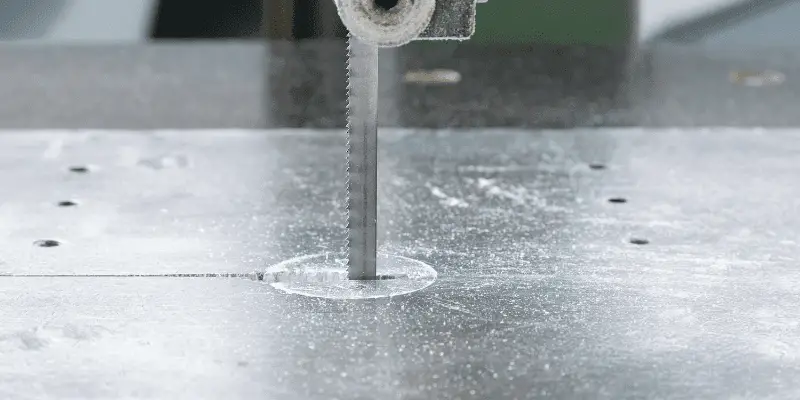A jigsaw is ideal for making intricate and curved cuts, while a bandsaw is best for cutting thicker materials in straight lines. Both tools are essential for woodworking and metalworking projects, and choosing the right one depends on the specific cutting requirements.
When selecting between a jigsaw and a bandsaw, it’s crucial to consider the type of cuts needed, the material being cut, and the desired precision. Understanding the differences between these tools will help you make an informed decision when tackling your next project.
This article provides an in-depth comparison between a jigsaw and a bandsaw, helping you to understand their unique features, applications, and limitations. Whether you’re a seasoned woodworker or a DIY enthusiast, having a clear understanding of these tools will enhance your craftsmanship and efficiency.
Understanding The Jigsaw And Bandsaw
When it comes to woodworking, having the right tools can make all the difference. Two power tools that are commonly used for cutting different materials are the jigsaw and the bandsaw. Understanding the differences and purposes of these two tools can help you make an informed decision on which one to use for your woodworking projects.
Purpose Of The Jigsaw And Bandsaw
The jigsaw is a versatile handheld power tool that is perfect for making intricate cuts and curves in wood, metal, and other materials. It’s ideal for cutting through thin or soft materials that require a high level of precision. On the other hand, the bandsaw is a stationary power tool with a continuous loop of teethed metal that is used to make straight and curved cuts in wood, metal, and other materials. It’s designed for larger and more heavy-duty cutting tasks.
Key Differences In Design And Function
| Aspect | Jigsaw | Bandsaw |
|---|---|---|
| Design | Handheld, with a narrow blade that moves up and down | Stationary, with a continuous loop blade that moves in a vertical or horizontal direction |
| Function | Ideal for intricate cuts and curves | Designed for larger, straight or curved cuts |
| Portability | Highly portable and versatile | Less portable due to its stationary design |
| Use | Suitable for DIY and small-scale projects | Used in professional workshops and larger woodworking projects |
Applications And Versatility
When it comes to power tools, versatility and applications play a crucial role in determining their utility in various woodworking and DIY projects. In this section, we will delve into the applications and versatility of both the jigsaw and bandsaw, highlighting their benefits and potential uses.
Jigsaw Applications And Benefits
The jigsaw is a versatile cutting tool that is well-suited for a wide range of applications, making it an essential addition to any woodworking toolkit.
- Perfect for intricate and curved cuts in materials such as wood, plastic, and metal.
- Ideal for cutting shapes and patterns, making it suitable for detailed craftsmanship and artistic projects.
- Offers the flexibility to make plunge cuts, bevel cuts, and miter cuts, enabling complex and precise cutting tasks.
- Portable and easy to maneuver, allowing for intricate cuts in tight spaces and corners.
Bandsaw Applications And Benefits
The bandsaw is a powerful cutting tool known for its stability and precision, offering a host of applications in woodworking and metalworking projects.
- Highly effective for straight and curved cuts in various materials, including wood, metal, and plastic.
- Capable of resawing and ripping large pieces of timber with accuracy and uniform thickness.
- Equipped with a larger cutting capacity, making it suitable for heavy-duty and large-scale projects.
- Allows for intricate and detailed cuts, making it a preferred choice for intricate woodworking tasks.
Precision And Accuracy
Precision and accuracy are crucial factors to consider when choosing between a jigsaw and a bandsaw for your cutting tasks. The ability to make precise cuts with accuracy can significantly impact the quality of your finished project. Let’s delve into the specifics of precision in cutting with a jigsaw and achieving accuracy with a bandsaw, exploring how these tools excel in delivering meticulous results.

Precision In Cutting With A Jigsaw
A jigsaw is a versatile tool that allows for intricate and detailed cuts, making it a go-to choice for projects that demand precision. Its thin, narrow blade and ability to make curved and intricate cuts make it ideal for tasks such as cutting out shapes, creating custom designs, or making smaller, detailed cuts. The jigsaw’s maneuverability and ability to navigate tight corners make it an exceptional tool for achieving precision in cutting.
Achieving Accuracy With A Bandsaw
A bandsaw, on the other hand, is prized for its ability to deliver accurate and straight cuts, particularly when working with larger pieces of material. The stability and control it provides enable woodworkers to maintain a consistent, precise cut throughout, resulting in clean and exact edges. Its capacity to handle thicker stock with ease further contributes to the overall accuracy of the cuts.
Considerations For Diy And Professional Use
Suitability Of Jigsaw For Diy Projects
Jigsaw is a versatile tool suitable for a wide range of DIY projects. Its ability to make curved cuts and intricate designs makes it ideal for tasks such as cutting out shapes, creating notches, or making plunge cuts. The jigsaw‘s portability and ease of use make it a popular choice for DIY enthusiasts looking to tackle home improvement projects, furniture making, or crafting endeavors.
Bandsaw: Ideal For Professional Woodworking
When it comes to professional woodworking, the bandsaw is often the tool of choice. Its ability to make precise straight cuts and resawing large lumber makes it a valuable asset in a professional workshop. The bandsaw is known for its stability, power, and accuracy, making it suitable for complex woodworking tasks that require a high level of precision and efficiency.
Decision Factors
When choosing between a jigsaw and a bandsaw, several decision factors must be considered to ensure that you make the right choice for your specific needs and projects. Consider the following factors to help weigh your options and make an informed decision.
Material And Thickness Considerations
One of the fundamental factors to consider when opting for a jigsaw or a bandsaw is the type of material and the thickness of the materials you will be working with. Jigsaws are well-suited for cutting softer materials such as wood, plastic, and thin metals, while bandsaws excel at cutting through thicker and denser materials such as hardwood, metal pipes, and heavy-duty plastics.
Workspace And Portability Requirements
Workspace and portability are vital factors that may influence your decision between a jigsaw and a bandsaw. Jigsaws are favorable for compact work areas and offer greater maneuverability, making them suitable for intricate and detailed cuts. On the other hand, bandsaws are ideal for larger workspaces and provide stability for cutting larger pieces of material. Consider the amount of space you have available and whether portability is essential for your projects.
Frequently Asked Questions On Jigsaw Vs Bandsaw
What Are The Differences Between A Jigsaw And A Bandsaw?
A jigsaw is versatile and suitable for cutting curves, while a bandsaw is better for straight cuts and resawing. Both have different blade types and work best for specific applications. Understanding their differences helps in choosing the right tool for the job.
Can A Jigsaw Be Used In Place Of A Bandsaw?
A jigsaw can be used for small and intricate cuts, but it lacks the power and precision of a bandsaw for larger and straight cuts. While they have some overlapping capabilities, each tool is best suited for specific tasks based on their unique features.
How Do I Choose Between A Jigsaw And A Bandsaw For My Woodworking Projects?
Consider the type of cuts you need to make, the material you are working with, and the level of precision required. A jigsaw is ideal for intricate cuts and smaller projects, while a bandsaw is better suited for larger pieces and straight cuts.
Understanding the specific requirements of your project is crucial in making the right choice between these two tools.
Conclusion
In the end, both the jigsaw and bandsaw have their specific uses in woodworking. The jigsaw is versatile, great for cutting curves, while the bandsaw is best for straight cuts. Depending on your project’s needs, choosing the right tool is crucial for achieving precision and efficiency in your woodworking endeavors.


